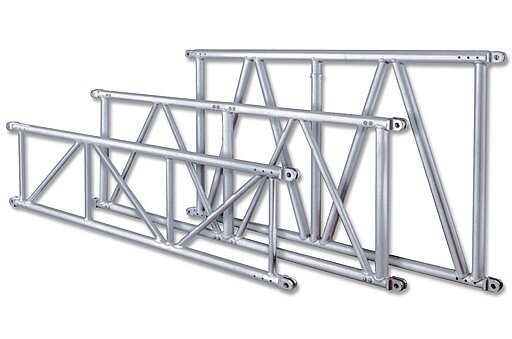There is NO difference between schedule 40 pipe and
batten pipe. Check with J.R
Clancy, SECOA, H&H et.al. Just to make sure we are all talking about the same thing, pipe intended for carrying fluids either in liquid form or gaseous form are measured and denoted by the inside diameter (I.D.). This is because that is the measurement that is relevant to the volume and flow rate of a fluid at a given pressure. Thus 1 1/2" pipe has an outside diameter of 1.9" virtually the same as 2" tube used for trusses. While many different sizes of pipe have been used and are currently in use, the most common is 1 1/2". Both Schedule 40 and schedule 80 are used with schedule 40 being the far more common. 2" pipe is not in common use as very few cast
iron "C" clamps will fit around it. 1" or 1 1/4" are suitable for curtain
track backbones where the support points are 5' on center, 1 1/4" is suitable for lighting battens if the support points are no more than 8' apart. Both 2" pipe and schedule 80 pipe are usually (not always) an inefficient solution to heavy loads and/or long spans between support points. Double pipe battens,
Ladder truss (or
Flat Truss) battens, made of two schedule 40 1 1/2" pipes are usually a better solution. Double battens are two separate pipes hung by a double pipe bracket, but not mechanically connected.
Ladder Truss battens are two pipes connected with 1/4"x2" plates about 10" long welded between the pipes on 4' to 5' centers. The 1" pipe listed in Fuchs old
book supported homemade strip lights that weigh a fourth of today's units and
fed by 2 to 6 14ga
asbestos covered wires, about one tenth the weight of today's SO multicable.
The most common size of pipe for
stage border lights was 1 1/2" as smaller on a 40' run could not provide enough gas at the end opposite the feed. Gas piping in houses and buildings was indeed used as
conduit in the early days of electricity replacing gas in indoor lighting, but not on
stage. The pipes were only above the
stage, flexible rubber tubes
fed to a "Gas Table" a large control center with valves and wheels that was the gas equivalent of a backstage
dimmer board. Gas lighting was a lot more than just holes drilled into a pipe. As early as 1820 it became obvious that plain holes quickly rusted shut from the H2O byproduct of a gas flame. It was also obvious that the
cone shaped flame produced by a round hole was very inefficient in producing visible light. The result was a
ceramic insert was screwed into the hole and the shape of the opening was altered to produce
flat flames of differing shapes. Over 200 patents were granted for inserts that produced different sizes and shapes of flame. The most common for theatrical use was the "Bat
Wing" flame. A secondary reason for the 1 1/2" size for the gas pipe was that it was self supporting and did not need to be hung from another support member. As electricity replaced gas there were many "combination" units make and sold. Check out the combination
unit in this old
Clancy catalog. Look on the 3rd catalog
page.
http://library.constantcontact.com/download/get/file/1102258086690-159/Theatre+DesTech+Fall10.pdf
Hoses to supply gas to the battens were very similar in size and manageability as today's multicable
electric feeds. They were a lot lighter however, gas being a
bit lighter than multiple #12 copper
wire and
insulation. Yes, fly systems were in use before gas light but mots pieces of scenery were flown directly from the lift lines.
System battens were rarely used. Battens were wooden and
commonly made of 2 pieces of what we would
call 1x3 or 1x4 today, sandwiched around the tops of drops and remained permanently with the
drop.
Batten clamps that look a
bit like a pair of tongs would clamp around the
batten and a 5 pound sand bag kept the lift lines taught when the
drop was removed.
2" pipe was cheaper than what?? Not cheaper than wood, not cheaper than 1 1/2" pipe.




